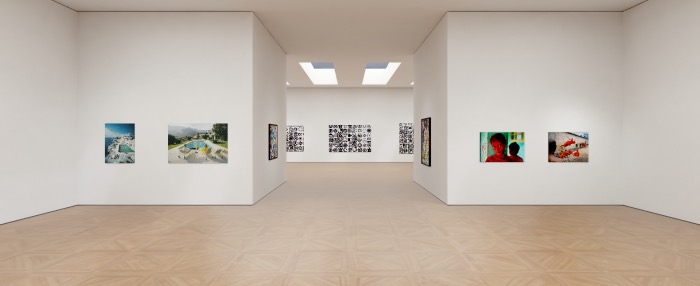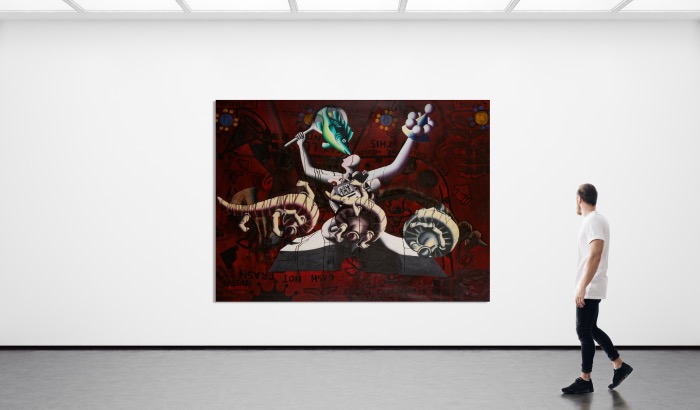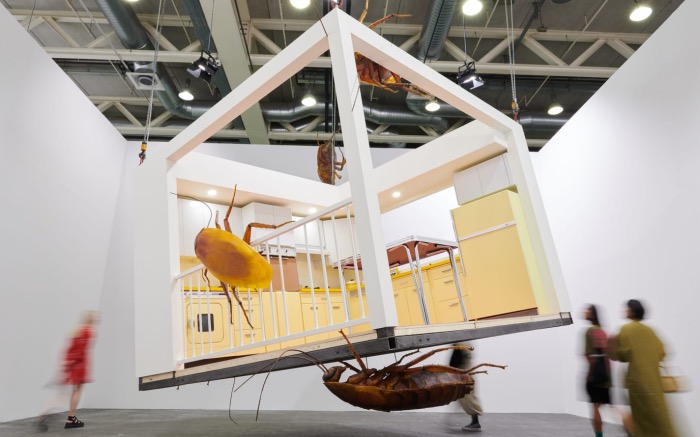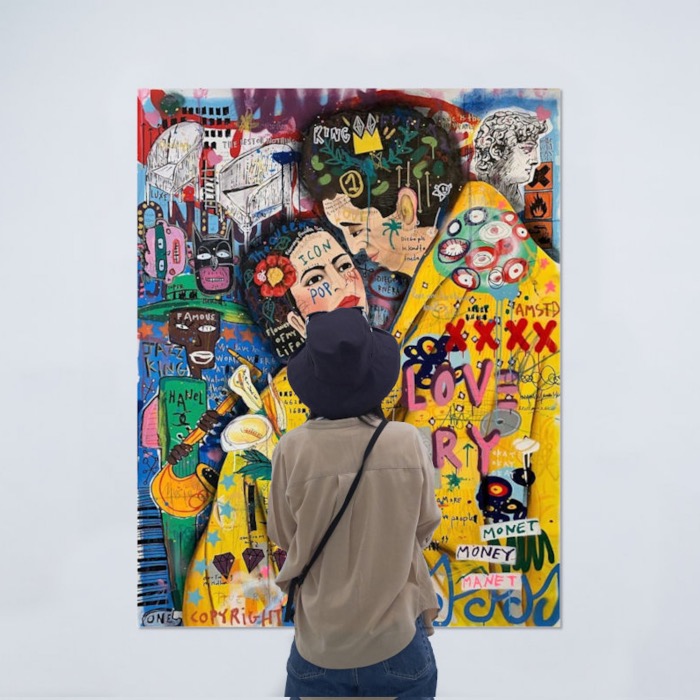
Courtesy: The Strip Gallery
I am pleased to host on my blog an article written by Martina Manco, director of The Strip Gallery of Contemporary Art, whom I had already interviewed on the occasion of the gallery’s first birthday and who now reveals all the secrets of becoming a successful art collector.
In the interview with Martina Manco it was clear that the world of collecting has undergone great changes lately, especially with the possibility of shopping online.
What then should be the attentions and tricks that a collector of today have? Here is the gallery owner’s answer.
Tricks and secrets for successfully collecting art
When people think of art, many believe that it is an exclusive world reserved only for a select few. In reality, anyone can become an art collector, regardless of their resources, and build up a collection of works of art of great (economic and emotional) value.
All you need to start collecting art is passion, knowledge, or even simple curiosity and the desire to explore a field that, once you are in it, we assure you will give you enormous satisfaction from many points of view.
We got to know many collectors who started this path with small savings and, over the course of a few years, managed to build up a successful art collection, with pieces that from a few thousand euros are now worth millions! And to the question “Would you sell your collection?”, they would answer “No thanks!”. The emotional value is often much more rewarding than the economic value!
Let’s therefore take a look in this article at how to become a successful art collector, analysing which are the main motivations for embarking on this interesting path, which are the right steps to take and which are the mistakes to avoid.
COLLECTING ART: WHY START
Why should one start collecting art? There is no single answer to this question. The reasons are different and can vary from person to person.
Questioning, therefore, several established art collectors, the answers could also vary widely. However, among the recurring motivations we will find:
- I collect art for investment.
- I collect art because it is a meaningful emotional and cultural experience.
- I collect art to furnish with taste and style.
There could be many other motivations but these three are undoubtedly the most recurring and, probably, if you are already a collector you will see yourself in one or more of these motivations for collecting art.
If the motivation is strong, the road to becoming a successful collector is already paved!
BECOMING AN ART COLLECTOR: HOW TO GET STARTED
Is your dream to become an art collector? Although the path is not short, it is also not as difficult as it might seem.
Here is some practical advice on the right steps to take.
Only collect what you like
Works of art very often reach very high figures, especially in recent years we are used to seeing works by ultra contemporary artists sold for hundreds of thousands or even millions of euros and this could lead anyone to think that it is enough to buy a work by any artist to find oneself a millionaire in a few months. It is not as simple as that, and although there are frequent cases of collectors making huge profits in the short term, our main suggestion is to collect what you like, what creates a deep emotion.
A successful art collector does not collect works just to sell them and make a profit, but first and foremost because they reflect his personal taste and style.

Mark Kostabi, Escape from The East Village, 1985-1990
Olio su tela
153 x 204 cm
Courtesy: The Strip Gallery
This also implies a certain eclecticism in their choice: the best collectors do not limit themselves to one genre or era, but often collect works of different artists, periods and styles, following their personal preferences and not just the value of the investment.
Get to know the art market
This step is crucial. Even if you have never leafed through an art book or a catalogue of art objects in your life, now is the time to do it.
Not sure where to start?
You could start by visiting the websites of the world’s best-known galleries, starting with ours, or the most popular art magazines (such as Arte and ArteIn).
Participate in exhibitions and fairs
We will never stop saying it: if you really want to become an art collector, you need to know what is happening in the world in this field, to know the changes, the new fashions, and then have the skills and ability to anticipate them.
The best way to do this is to take part in all the major events that concern the sector: exhibitions, fairs and shows promoted in your city are certainly the starting point, but also try to get out of your ‘comfort zone’.
Going to an event outside your usual route (another city or even another country) can allow you to broaden your horizons, learn about new trends and meet people who can guide you along the way.
One of the fairs that excites us most internationally is Art Basel, which brings together the world’s most famous and renowned galleries every year in Basel and brings together all the artists the market is focusing on at the time.

Visitatori presso la sezione Unlimited di Art Basel – Basilea
Courtesy: Art Basel website
Other high-quality fairs are TEFAF in Maastricht and, in Italy, Arte Fiera Bologna and Miart in Milan.
Buy art online
One of the most immediate ways to surround yourself with art is to buy it online. The main advantage of the internet is that it allows you to explore art and trends from around the world conveniently via your electronic devices, anywhere in the world.
In this case, our advice is to always turn to certified art selling platforms and the websites of recognised galleries and, above all, to always ask about the state of preservation of works of interest.
Many collectors also buy works of art from platforms such as eBay and the like but, in such circumstances, it is best to take extra care and rely on the advice we will detail below.
Keep an eye on young artists
The art collector is, by nature, a talent seeker: he therefore does not limit himself to buying the works of already famous and recognised artists, but aims first and foremost to unearth talented but still little-known artists.
This strategy also has an advantage: not only are young talents easier to find as they are not yet snapped up by the most prestigious art dealers and galleries, but their works can also be bought at much more reasonable prices.
We just happened to meet a German collector in the last few days who had acquired a work by Banksy for a derisory sum when nobody was buying his graphics yet, and today, that same work has a valuation of around 120,000 euros and a resale time that is practically immediate!

Jisbar, Frida and Diego, 2021 Tecnica mista su tela
146 x 114 cm
Courtesy: The Strip Gallery
MISTAKES TO AVOID AND TIPS FOR THE SUCCESSFUL COLLECTOR
What should you never do when you want to start collecting art? Read on and you will find out.
Don’t make sure you have the right documents
Once you have started to buy your first works, always make sure that together with the painting, sculpture and/or photograph or graphic art you have bought, you are also given all the necessary documents to prove the provenance and authenticity of the work.
This information is crucial not only to increase the value of the artwork, but also to give it “meaning” within your collection.
For one-edition works of art there is always a certificate issued by the artist or the relevant Foundation/Archive, or a certificate of authenticity issued by the gallery representing the artist (this practice is generally more common for American artists who are used to not issuing authentications, delegating this function to the relevant galleries).
We always recommend verifying the certificates accompanying the work of art by making a request directly to the person who issued them, as it is not uncommon for fake works of art to be accompanied by fake certificates. For example, in our case, even if the works of art that we handle are accompanied by a certificate of authenticity from an artist’s archive, we usually write an e-mail to that entity to ensure that everything is correct.
Attention should also be paid to provenance, it is often even more important than certificates of authenticity, for two reasons:
- prestigious provenance can significantly increase the value of the work of art;
- the provenance of the work is always necessary to prove that the work was acquired lawfully.
In the case of purchases from private individuals, we always suggest getting a declaration of origin and checking the certificates that are delivered.
In the case of graphic works, the situation is more complex as there are generally no certificates of authenticity for these works, with the exception of certain artists such as Banksy (for whom there is Pest Control which certifies the goodness of the artist’s work) or Andy Warhol (for whom there used to be the Andy Warhol Foundation, but this has now been out of business for many years and therefore many of Warhol’s graphic works do not have any certification).
In such cases, what counts is always the provenance and reliability of the seller; as well as the experience and knowledge of the collector who is buying.
Buying based on price alone
One of the mistakes most often made by budding collectors is to think that a work of art that is sold for less than its market price is automatically a bargain. There are very few cases in which a collector sells out his artwork or sells it for much less than market price.
More often than not, such situations conceal pitfalls and problems from which one should stay away!
Many collectors do not realise that the risks involved in saving a few euros are far more important and costly than the savings themselves!
Works of art with illicit provenance, fake works of art, works with fake certificates, illegally stolen works, etc. can all be reasons why a work of art is sold at a lower price and to which you should pay close attention.
Therefore, when you come across a work of art for which the asking price is well below the market price, check the seller’s documents, provenance and reliability carefully. If something does not add up, you should abandon the purchase!
Do not build relationships
No human being is an island, least of all an art collector!
If you really want to build a future as a collector, even if only for passion, you need to make an effort to build relationships with gallery owners, exhibition curators, other collectors and art experts in general.
This will also allow you to be better informed about new emerging artists and all the major trends in art that are on the horizon.
Having too high a budget
Needless to say, one of the main obstacles to becoming an art collector is financial availability. However, this is often only a false problem: you do not need to have a large budget to start collecting art; you can easily decide to devote only a small part of your savings to this passion (or investment).
As you increase your skills and your collection starts to grow, you can also decide to increase your budget by finding new resources from other investments you have made in the past.
Finally, our suggestion is to also consider purchasing artworks with payment in instalments. Unfortunately, not all galleries provide this opportunity, which we offer free of charge and which we consider to be extremely important for any collector.
TRICKS AND SECRETS FOR A SUCCESSFUL COLLECTION
For the collector/investor, it is of paramount importance to build up a collection of art works that not only arouses emotions and tells a story of personal growth, but also increases its economic value over a period of time.
The truth is that it very often happens that the collector who carefully chooses the works in his collection, without even paying attention to the investment factor, nevertheless finds himself after a few years with works of art whose value has increased considerably over time.
But how is this plus-value generated and why can an artist’s prices explode upwards?
As with all markets, an artist’s publicity and notoriety influence his market. In the art world there are many galleries that have the capacity and resources to follow an artist both artistically and economically and for investment purposes.
As the number of exhibitions, museum placements, participation in biennials and institutional events, and the notoriety that the artist and his or her gallery of reference achieve increases, there will almost always be an important reflection on the quotations of that artist.
It is obvious that an artist needs to exhibit his work in order to make himself known to the public, critics, collectors, museums and institutions. The greater his or her ability and that of the relevant gallery to exhibit the artist’s work, the greater the chances of economic success.
The greatest contemporary artists are almost always followed by top art galleries, which manage the artist’s career intelligently and with targeted strategies.
Therefore, the collector/investor who wants to have a better chance of purchasing works of art that can increase in value over time, must also necessarily observe which galleries represent and follow the respective artist.
SALES METHODS AND CHANNELS MAKE A DIFFERENCE
Not everyone dwells on this detail, but the way in which artwork is sold and its channel also plays a role.
Any artist has two options to sell the artwork he or she creates: direct sale or sale through a gallery.
You will easily notice that, with the exception of very few artists in the world, no successful artist sells his or her artwork privately, as he or she delegates this activity to his or her gallery of choice.
Damien Hirst, Jeff Koons, Kaws etc… none of these artists will ever respond to the requests of a collector who wants to buy a work of art from them!
Although it may seem cheaper for a collector to buy a work directly from the artist, in the long run this choice proves to be counterproductive most of the time.
Let us assume that an artist decides to sell his artwork privately and that, as often happens, at some point he decides, out of greed or necessity, to lower his prices in order to sell it as quickly as possible to as many collectors as possible.
The buyers will increase exponentially and will certainly be very happy as they are sure that they have just made a bargain.
After some time, all these works will end up on the market and having been acquired at derisory prices, the relevant collectors will be content with a price even lower than the market value. The chain reaction will be immediate and will destroy the market for that artist.
Therefore, always pay attention to the channels an artist uses to sell his or her artwork. Although it may seem inconvenient to buy from the gallery representing the artist, the long-term benefits may be significant!
HOW TO VALUE WORKS OF ART
With the same size, year and techniques, two works of art can have extremely different values.
A work exhibited at the Guggenheim will have a much higher economic value than a similar work that has no exhibition.
Therefore, the successful collector will always be careful to try to place his or her artwork in the most important and prestigious exhibitions, knowing that the more a work of art has been exhibited and published, the more its recognition and value will increase.
QUALITY FIRST!
Not all works of art are equal. The most valuable ones are of the highest quality.
Always aim for the quality of the works of art you acquire, even if you have to pay more, because those will be the works that will set records when an artist’s work rises in value.
Works of art of lesser quality, secondary, unsuccessful works and drafts will always sell with greater difficulty.
Therefore, if you have to choose between 5 non-quality and 1 quality work of art, we suggest you acquire the one quality work of art without any doubt.
It seems that becoming a collector is within everyone’s reach, but the concept that it is better to rely on the “expert hands” of a professional who knows how to direct our steps and avoid nasty surprises is still valid.
The Strip Gallery of Contemporary Art is certainly a point of reference for today’s collectors and you can have a look at its website to see which artists are best to focus on.

